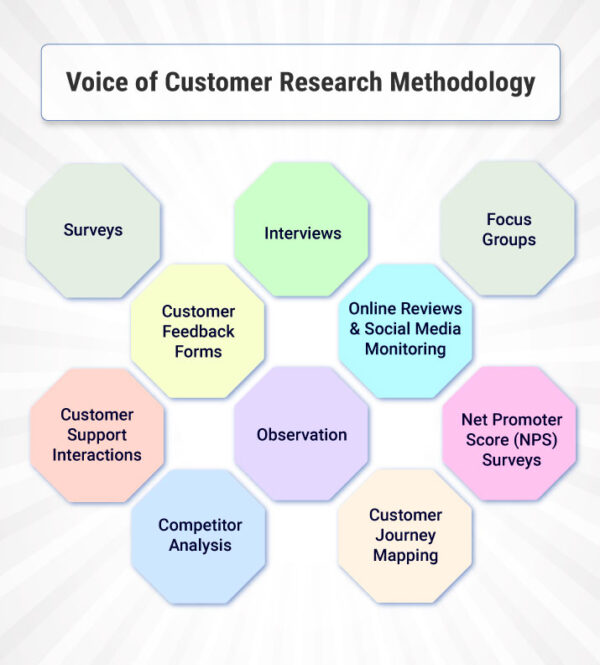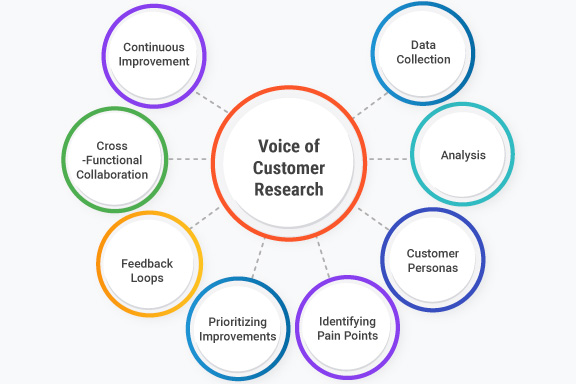Table of Contents
What is Voice of Customer (VoC) Research?
Voice of Customer (VoC) research is defined as a systematic process of collecting and analyzing customer feedback, opinions, and preferences to gain insights into their needs, expectations, and overall satisfaction with a product, service, or brand. The primary goal of VoC research is to understand the customer’s perspective and use this information to make informed decisions, improve products or services, and enhance the customer experience.
Here are some key components and steps involved in Voice of Customer research:
- Data Collection: VoC research involves various methods for collecting customer feedback, including surveys, interviews, focus groups, social media monitoring, online reviews, and customer support interactions. These methods can be quantitative (numerical data) or qualitative (textual or narrative data).
- Analysis: Once data is collected, it is analyzed to identify patterns, trends, and themes. This analysis helps in extracting meaningful insights from customer feedback.
- Customer Personas: Creating customer personas is a common outcome of VoC research. Personas are fictional representations of different customer segments, based on their characteristics, needs, and preferences. These personas help organizations better understand their target audience.
- Identifying Pain Points: VoC research helps in pinpointing specific pain points and issues that customers face in their interactions with a product or service. This information can guide improvement efforts.
- Prioritizing Improvements: After identifying customer needs and pain points, organizations prioritize which improvements or changes to make based on the severity of the issues and their impact on customer satisfaction.
- Feedback Loops: VoC research often establishes feedback loops where customer feedback is continually collected and used to drive ongoing product or service enhancements.
- Cross-Functional Collaboration: VoC research often involves various departments within an organization, including marketing, product development, customer support, and sales, working together to address customer needs effectively.
- Continuous Improvement: VoC research is not a one-time effort; it’s an ongoing process. Organizations should regularly collect and analyze customer feedback to stay responsive to changing customer preferences and market dynamics.
Benefits of Voice of Customer research include:
- Improved customer satisfaction and loyalty.
- Enhanced product or service quality.
- Better-informed product development and marketing strategies.
- Increased competitiveness in the marketplace.
- Reduced customer churn and increased retention.
In summary, Voice of Customer research is a valuable tool for organizations to gain a deeper understanding of their customers and use that knowledge to drive improvements in their products, services, and overall customer experience.
Learn more: What is Research Design?
12 Voice of Customer Research Methodology

Voice of Customer (VoC) research uses various methodologies to collect and analyze customer feedback and insights. The choice of methodology depends on your specific goals, resources, and the nature of your business. Here are some common VoC research methodologies:
1. Surveys
Online surveys: Create questionnaires using tools like SurveyMonkey or Google Forms and distribute them to your customer base via email, your website, or social media.
Phone surveys: Conduct interviews with customers over the phone to gather feedback. This method can be more personal but may require more resources.
2. Interviews
In-depth interviews: Conduct one-on-one interviews with customers to gain a deeper understanding of their experiences, needs, and preferences. These interviews can be done in person, over the phone, or via video conferencing.
3. Focus Groups
Organize small focus group discussions with customers to facilitate open conversations and gather qualitative insights. This method is particularly useful for exploring perceptions and attitudes.
4. Customer Feedback Forms
Collect feedback through feedback forms integrated into your product or service. This allows customers to provide input directly within the context of their experience.
5. Online Reviews and Social Media Monitoring
Analyze online reviews on platforms like Yelp, Amazon, and social media mentions to gather insights into customer opinions and sentiment about your brand or products.
6. Customer Support Interactions
Review customer support interactions (e.g., emails, chat transcripts, and phone call recordings) to identify common issues and pain points raised by customers.
7. Observation
Observe customer behavior and interactions with your product or service. This can be done in physical settings or by analyzing user behavior on your website or app.
8. Net Promoter Score (NPS) Surveys
Utilize NPS surveys for assessing customer loyalty and contentment. Customers are asked to rate their likelihood of recommending your product or service to others on a scale of 0 to 10.
9. Text Analytics
Employ natural language processing (NLP) and text analytics tools to analyze open-ended responses, online reviews, and social media comments for patterns and sentiment analysis.
10. Competitor Analysis
Compare your product or service with competitors by analyzing customer reviews, ratings, and feedback on similar offerings in the market.
11. Customer Journey Mapping
Map out the customer journey to identify touchpoints and pain points throughout the customer’s interaction with your brand, from initial awareness to post-purchase support.
12. Ethnographic Research
Immersing researchers into the customer’s environment to gain a deep understanding of their behaviors, needs, and challenges.
When conducting VoC research, it’s essential to ensure that the data collected is representative of your customer base and that you maintain customer privacy and data security. Additionally, it’s crucial to analyze the collected data thoroughly, draw actionable insights, and use these insights to drive improvements in your products, services, and customer experience. VoC research should be an ongoing process to adapt to changing customer preferences and market conditions.
Learn more: What is Consumer Research?
15 Best Practices of Voice of Customer Research
Voice of Customer (VoC) research is a valuable tool for understanding your customers’ needs and improving your products, services, and overall customer experience. To ensure the effectiveness of your VoC research, consider the following best practices:
- Clearly Define Objectives: Start by defining clear and specific research objectives. What specific insights or information are you seeking to gather from your customers? What problems are you trying to solve? Having well-defined goals will guide your research efforts.
- Select the Right Methodologies: Choose research methodologies that align with your objectives and target audience. Use a mix of quantitative and qualitative methods, as both can provide valuable insights.
- Segment Your Audience: Segment your customer base to tailor your research to specific customer groups. Different segments may have unique needs and preferences, and understanding these variations is essential.
- Sample Size and Selection: Ensure that the size of your sample is statistically significant to derive meaningful conclusions. Randomly select participants to avoid bias in your data.
- Design Effective Surveys and Questions: Craft surveys and interview questions carefully. Use clear and concise language, avoid leading questions, and include a mix of closed-ended (quantitative) and open-ended (qualitative) questions.
- Capture the Entire Customer Journey: Gather feedback at multiple touchpoints throughout the customer journey, from initial awareness to post-purchase support. This offers a comprehensive perspective of the customer experience.
- Engage with Customers Actively: Engage with customers during the research process to build rapport and trust. This can lead to more candid and valuable feedback.
- Implement a Closed-Loop Feedback System: Establish a system for closing the loop with customers, meaning you acknowledge their feedback and communicate the actions you’re taking to address their concerns. This builds customer trust and loyalty.
- Analyze Data Thoroughly: Use data analysis tools and techniques to uncover patterns, trends, and insights. Pay attention to both quantitative metrics and qualitative feedback for a comprehensive understanding.
- Prioritize and Act on Insights: Prioritize the most critical issues and opportunities identified through VoC research. Create action plans and allocate resources to address these areas promptly.
- Share Findings Across the Organization: Ensure that the insights gained from VoC research are shared with relevant teams and departments within your organization. This promotes cross-functional collaboration and alignment.
- Iterate and Continuously Improve: VoC research should be an ongoing process. Continually collect feedback, make improvements, and monitor the impact of those changes. Adjust to changing customer requirements and shifts in market conditions.
- Protect Customer Privacy: Handle customer data with care and in compliance with relevant data privacy regulations. Anonymize data when necessary to protect customer identities.
- Train and Empower Employees: Train employees in customer-centric practices and empower them to act on customer feedback. Promote a culture of customer-centricity across the entire organization.
- Benchmark and Compare: Benchmark your performance against industry standards and competitors to gain insights into where you stand relative to others in your market.
- Stay Agile: Be flexible and adaptable in your approach. Customer preferences and market dynamics can change rapidly, so be prepared to pivot your strategies accordingly.
By following these best practices, you can ensure that your Voice of Customer research is a valuable and ongoing process that helps you meet customer needs and stay competitive in your industry.
Learn more: What is Primary Market Research?
Most Recent Blogs
Explore the latest innovation insights and trends with our recent blog posts.










